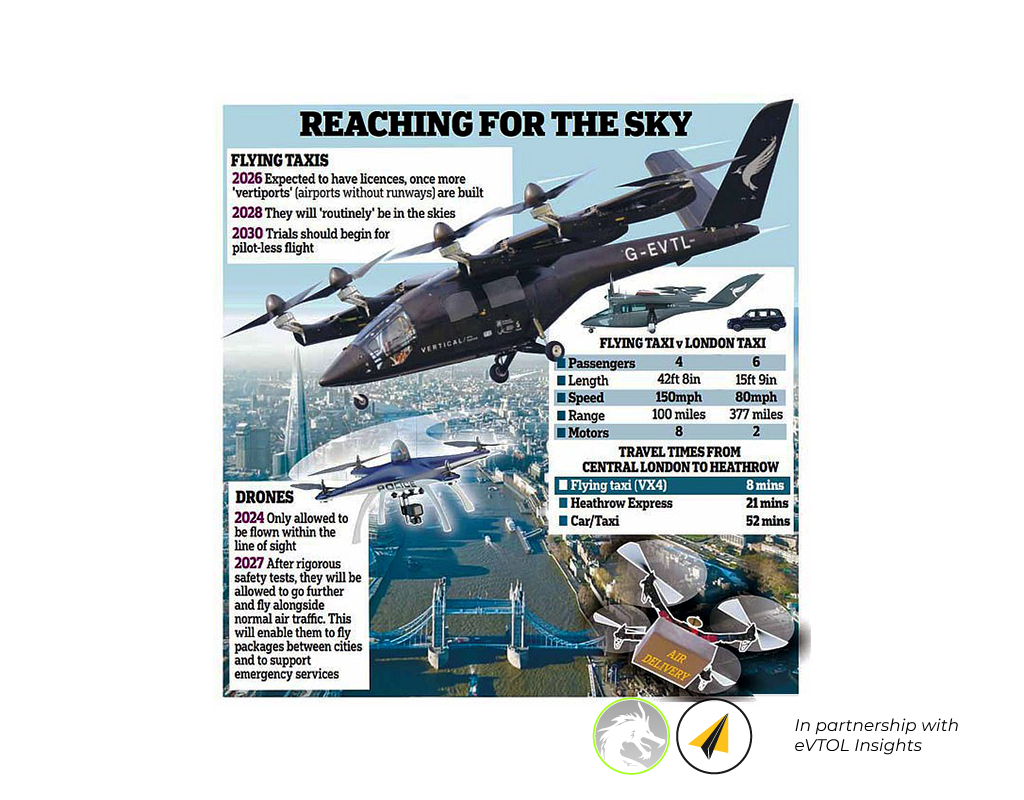
Flying taxis will be whizzing around the British skies by 2028. The UK Government has said so. It is part of a new action plan spearheaded by the industry’s joint Future of Flight and announced by the Department for Transport (DFT), reports a press release. While drones will assist the emergency services as well the police to fight crime.
Ministers will today (March 18th) set out ambitious plans to turn this “Jetson-science-fiction idea” into reality by overhauling current regulations and infrastructure. The hope is for flying taxis to be first piloted by 2026; then to routinely fly overhead by 2028; and, more surprisingly, operate autonomously just two years later.
Meanwhile, drones will be using the low-altitude airspace to deliver emergency supplies as well as to tackle crime. Ministers believe this aeronautical green revolution could boost the UK economy by UKP45 billion come the end of this decade.
Anthony Browne, UK Aviation and Technology Minister, commented, “Cutting-edge battery technology will revolutionise transport as we know it. From flying taxis to emergency service drones, we’re making sure the UK is at the forefront of this dramatic shift in transportation – improving people’s lives and boosting the economy.” He added, “This plan will make sure we have the infrastructure and regulation in place to make it a reality.”

Anthony Browne
The “action plan” is unveiled on the same day as Browne visits the leading UK eVTOL company, Vertical Aerospace in Bristol. The company is building and trialling its all-electric VX‑4 and will be showcasing latest developments along with proposed demonstration flights at the Farnborough Airshow in July.
Stephen Fitzpatrick, Founder and CEO of the company, remarked, “The UK has a long heritage in aerospace and the publication of this plan sets out how we will lead the next revolution of flight. With government and business working together, we can unleash the huge economic, environmental and social benefits of zero emissions flight globally.”
First imagined in the Flightpath to the Future in 2022, this joint plan between industry and government sets out the strategic direction of the sector over the next 5 years, striking a balance between innovation, security, safety and cutting emissions.
Other proposals include:-
- Allowing drones to fly Beyond Visual Line of Sight (BVLOS), so that the sector can grow without limiting the skies for other aircraft.
- Breathing life into smaller aerodromes by setting out how they can operate as vertiports for eVTOLS.
- Developing standards to improve security for drones to boost public safety.
- Engaging communities and local authorities so that they can enjoy the economic and social benefits of these technologies.

West Midlands Police and Successful Deployment of Drones (Credit: West Midlands Police)
The benefits of employing drones is already seen in the UK, where the West Midlands Police uses these craft to tackle violent crime and antisocial behaviour. Last July, a drone team was deployed, successfully identifying two offenders and another suspect at a speed and distance that would have taken ground officers hours to track down.
Drones are also assisting frontline NHS staff to save lives. For six months between October 2022 and March 2023, the UK drone service provider Skyfarer partnered with University Hospitals Coventry and Warwickshire NHS Trust and Medical Logistics UK delivered surgical implants and pathology samples between sites. In one case, drones reliably helped cut delivery times between Coventry and Rugby hospitals from up to an hour to just 18 minutes or a 70 percent decrease.
Duncan Walker, CEO of Skyports and Chairman of the Future of Flight Industry Group, said, “The UK is home to one of the world’s most important aerospace industries and is in an ideal position to be a pioneer in the next era of aviation. The government and industry have a joint commitment to support the development, industrialisation and introduction of new aviation technologies. Continued collaboration will ensure that we capitalise on the significant domestic and international market opportunities presented by the future of flight.”
The release explains, “The Future of Flight action plan contains measures to make drone applications and assessments easier by creating new and simple digital platforms that operators can use – ensuring companies and public services are no longer shackled by red tape and get drones up and flying quicker.”
It goes on, “It will also enable the development of vertiports – mini-airports for drones and electric aircraft that take off vertically – by developing certification standards and reviewing the use of existing infrastructure to deliver at speed, boost safety and security and put the passenger first.”

Skyfarer and Medical Logistics Trial Delivering Surgical Implants and Pathology Samples (Credit: Skyfarer)
Industry partners are to undertake multiple industry-leading trials to explore new ways to operate drones BVLOS as well as demonstrate electric aircraft by keeping accidents to a minimum and making the most of technological advances. This could include finding and repairing faults more quickly on the railway network leading to fewer delays and cancellations for train passengers.
The release adds, “By supporting R&D in electric aircraft and drones, and with the help of key partners like the CAA, the action plan aims to usher in a new era of eco-friendly aviation and boost the economy with new investments, ensuring the UK captures the full potential of this emerging global industry as a force for good and a driver of growth.”
Sophie O’Sullivan, Head of Future Safety and Innovation at the UK Civil Aviation Authority, commented, “Aviation stands on the cusp of its next, potentially biggest, revolution since the invention of the jet engine. Drones, eVTOL and other different vehicles have the potential to change transportation options forever. Our role in this bright future of aviation will be enabling technological advances and providing regulatory support while ensuring that all forms of new aviation technology enjoy the same high safety standards as traditional aviation.”
For more information
https://vertical-aerospace.com/
https://www.gov.uk/government/publications/future-of-flight-action-plan

